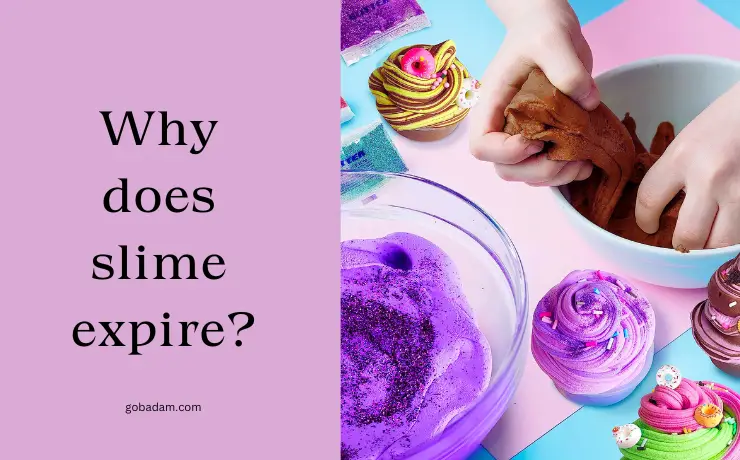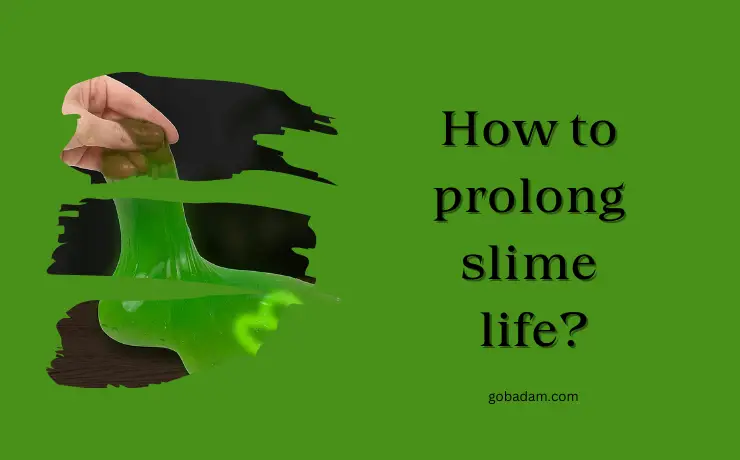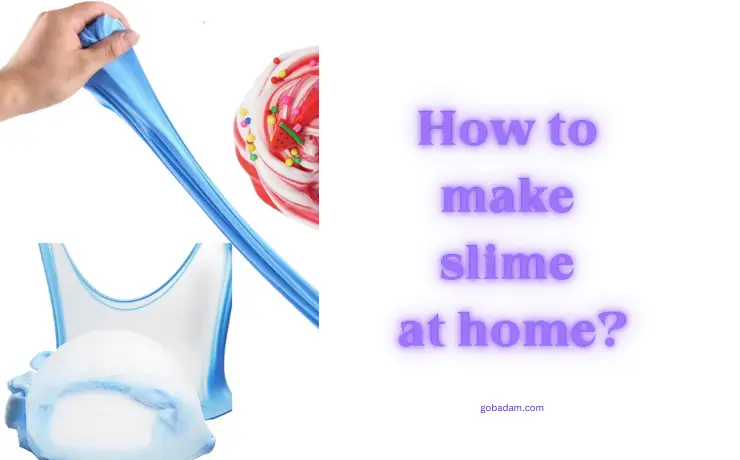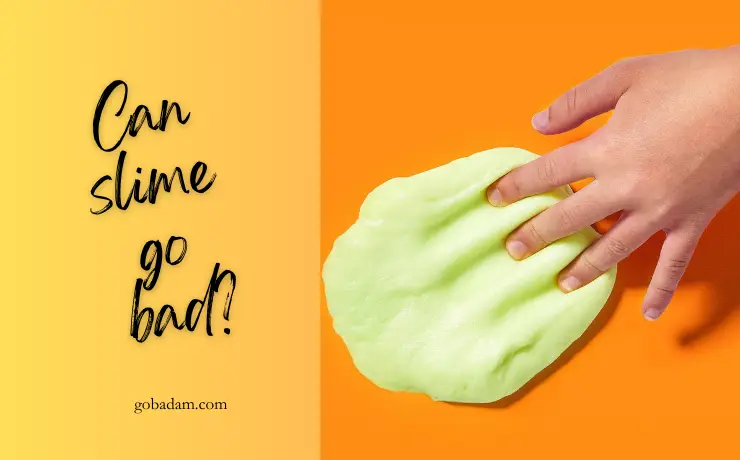Can slime go bad? Of course, there’s a great curiosity worldwide about whether such a popular product loved by children will spoil or not. The points to consider when it comes to our children’s use are increasing. Extra hygiene precautions, proper storage conditions, following guidelines and instructions, and paying attention to expiration dates or best before dates if present.
In this article, I decided to prepare informative content for those who want to explore the fluid world of slime. Let’s discover together whether slime spoils or not, how we can preserve it for the optimal duration like the first day, and many more things about slime.
Can Slime Go Bad? (Does slime go bad?)
Yes, slime can go bad or degrade over time. Here are some signs that slime has gone bad or reasons why it might deteriorate:
Mold Growth: If slime is stored in a warm, damp environment, it might develop mold or mildew over time, especially if there are organic ingredients in the slime.
Change in Consistency: Over time, slime might become too sticky, too hard, or too brittle. These changes can be due to factors like the evaporation of water or other volatile components, or the breakdown of certain ingredients.
Unpleasant Odor: If your slime starts to give off an unpleasant or foul smell, it’s a good indicator that it has gone bad.
Separation: Some slimes might separate into their individual components or liquids might pool on the surface.
Ingredients: Some ingredients, like food items or perishable additives, can cause the slime to degrade faster.
If you think your slime has gone bad, you can purchase a new one.
SEE OFFER 👉🏻 Non toxic slime kit for toddlers
Why does slime expire?
Slime can degrade or “expire” over time due to several reasons:
👉🏻Ingredients Break Down: The components that make up slime, such as PVA (polyvinyl alcohol) in white glue, can break down over time, especially when exposed to air, moisture, or contaminants.
👉🏻Moisture Evaporation: Slime can lose moisture over time, especially if not stored properly. When the water content decreases, the slime can become hard or brittle.
👉🏻Chemical Reactions: Some ingredients in slime might continue to react over time. For instance, if borax and glue continue to interact, the slime can become increasingly rubbery or too hard.
👉🏻Additives and Perishable Ingredients: Slimes that have additives, like food items, scents, or other perishable ingredients, can degrade faster. These ingredients can spoil, leading to off smells, discoloration, or other changes in the slime’s consistency.
👉🏻Separation: Over time, some slimes may separate into their constituent components. This can be due to gravity or the different densities of the ingredients used.
👉🏻External Contaminants: Things like dust, hair, or small particles can get mixed into the slime during play, which can affect its consistency and longevity.
👉🏻Exposure to Sunlight: UV rays can break down certain chemicals in slime, altering its texture and consistency.

Does slime get moldy?
👉🏻Mold and Bacteria Growth: Slime can be a breeding ground for mold and bacteria, especially if it’s been contaminated by dirty hands or stored in a warm, moist environment. Organic ingredients or additives in the slime, such as food items, can further enhance the risk of microbial growth.
To maximize the lifespan of slime, it’s essential to store it properly, usually in an airtight container in a cool, dry place, and to handle it with clean hands. However, even with the best care, most slimes will degrade over time and may eventually need to be discarded.
How to prolong slime life?
To extend the life of your slime you should follow some instructions and storage tips. Here are some most common ones.
👉🏻Store it in an airtight container. Exposure to air may cause changes in form and drying.
👉🏻Keep it away from direct sunlight or heat. Since heat can change the chemistry of slime, it can be one of the factors that will speed up the deterioration process.
Avoid adding perishable ingredients.
👉🏻Wash your hands before handling to avoid introducing contaminants. You don’t want to transfer bacterial growths to your slime.
It’s always a good idea to inspect homemade slimes regularly and discard any that show signs of spoilage, especially if they are used by children. Commercially produced slimes might contain preservatives that extend their shelf life, but even these can degrade over time.

How to make slime at home?
You can make your own slime at home with a few simple ingredients. Here is the slime recipe without glue.
We place the ingredients into a deep and round bowl. We add 4 drops of food coloring to 4 tablespoons of shampoo. We mix it well with the help of a spatula. If we want a more intense color, we can add a bit more food coloring.
Then, we add 4 tablespoons of cornstarch to this mixture and continue to mix. We can add more cornstarch for a thicker consistency. However, doing this might harden the slime dough, so it’s best to be cautious.
LEARN 👉🏻 Does Cornstarch Go Bad?
Remember, the lifespan of homemade slime will be shorter than those sold outside.

Slime storage tips
Here is a RECAP for slime storage tips. Despite following all these rules, it is useful to change your slime periodically as a personal hygiene requirement.
- What containers are best for slime? Use airtight containers while you don’t play with slime.
- Do not expose your slime to direct sunlight.
- No heat or warm places.
- Before touching the slime, hands must be washed with antibacterial soap and dried well.
- When you’re done, store your slime in an airtight container.

Can you store slime in a plastic container?
Yes, you can store slime in a plastic container. In fact, a plastic container is one of the most recommended storage solutions for slime. Here’s what you need to know about storing slime in a plastic container:
Airtight Seal: Choose a container with a tight-sealing lid to prevent air from getting in.
Clean Container: Make sure the plastic container is clean and dry before placing the slime in it. Any moisture or residue can affect the slime’s consistency or introduce contaminants.
Size Matters: It’s ideal to use a container that’s just a bit larger than the volume of the slime. Too much empty space can allow for more air, which might dry out the slime faster.
Avoid Sharp Objects: Ensure that the inside of the container doesn’t have any sharp edges or points that might tear or damage the slime.
Check Regularly: Especially if the slime is homemade or contains perishable ingredients, it’s a good idea to inspect it regularly for signs of mold, unpleasant odors, or any other indications that it might have gone bad.
Single Use: If you’re using multiple slimes, store each type or color in its own separate container to prevent colors from blending and to maintain each slime’s unique consistency.
Storing slime in a plastic container helps prolong its usability and keeps it fresh. However, even with proper storage, slime might not last forever, so always check its condition before use, especially if it’s been stored for an extended period.
Why is Slime popular worldwide?
Slime’s worldwide popularity can be attributed to several factors:
Sensory Experience: Slime provides a unique tactile experience. The act of kneading, stretching, and poking slime can be incredibly satisfying and relaxing. Many people find it therapeutic and a great stress-reliever.
DIY Aspect: Making slime at home is straightforward and allows for creativity. People can customize their slime with different colors, textures (e.g., adding beads or glitter), and even scents. The DIY nature of slime-making means individuals can tailor the experience to their preferences.
Social Media Trend: Slime gained massive popularity on platforms like YouTube, Instagram, and TikTok. ‘Slime videos’ often show the making and handling of slime, producing ASMR-like effects that many viewers find satisfying. The ease with which these videos can be shared has contributed to slime’s global trend.
Educational Angle: Slime can be used in educational settings to teach children about chemical reactions (like the reaction between borax and glue). It offers a hands-on, fun way to learn science.
Affordability: Most ingredients required to make basic slime (like white glue, borax, and food coloring) are inexpensive and readily available.
Safe and Non-toxic: While there have been concerns about certain slime recipes, many non-toxic alternatives are available, making it a relatively safe activity for kids with proper supervision.
Versatility: Slime isn’t just for kids. Adults have also embraced the trend, incorporating slime into themed parties, events, or even using it as a desk toy to help with focus and relaxation.
Cultural Crossover: As with many trends, once slime became popular in one region or country, its appeal quickly spread to others, facilitated by global communication and e-commerce platforms.
In summary, the sensory satisfaction combined with the DIY aspect, social media influence, and educational potential has propelled slime to global popularity. However, like all trends, the intensity of its popularity may wane over time, but its appeal as a sensory and educational tool will likely persist.
Benefits of playing with slime for toddlers
Playing with slime offers a range of benefits for toddlers, including:
👉🏻Sensory Exploration: Toddlers are at a stage where they’re constantly exploring the world through their senses. The unique texture and consistency of slime allow them to engage their sense of touch, enhancing tactile awareness.
👉🏻Fine Motor Skill Development: Manipulating slime—stretching, rolling, pinching, and squishing—helps in developing fine motor skills, which are crucial for tasks like writing, buttoning, and using utensils as they grow older.
👉🏻Hand-Eye Coordination: As toddlers move and manipulate the slime in different ways, they are practicing and refining their hand-eye coordination.
👉🏻Cognitive Development: Playing with slime can stimulate a toddler’s curiosity and imagination. They can also begin to understand concepts like cause and effect (e.g., when they mix colors or see how slime reacts to being stretched vs. squished).
👉🏻Calming Effect: The sensory experience of playing with slime can be soothing for many toddlers. It can act as a stress-reliever or an activity to help them focus.
👉🏻Creativity: Toddlers can integrate other toys or objects into their slime play, creating imaginative scenarios or just experimenting with shapes and structures.
👉🏻Scientific Exploration: Even at a young age, toddlers can begin to get a sense of basic scientific concepts. For example, they can observe the slime’s properties, like its stretchiness or how it oozes.
👉🏻Social Interaction: When played in groups, slime can promote sharing, cooperation, and other social skills as toddlers interact with each other and the material.
However, while there are numerous benefits, it’s essential to ensure the safety of toddlers when playing with slime. Ensure that the slime is non-toxic, and always supervise playtime to prevent ingestion or other potential hazards. It’s also advisable to check for allergies or skin sensitivities, especially if the slime has added ingredients like fragrances or dyes.
SEE OFFER 👉🏻Play Doh slime pack

Frequently Asked Questions About Can Slime Go Bad
Here are top questions about slime expiration date, signs for spoilage, how to keep slime fresh and more.
How long does unopened slime last?
Unopened slime, especially commercially-produced varieties, can last significantly longer than its homemade counterpart due to preservatives and optimized packaging.
Typically, when stored in a cool, dry place away from direct sunlight, unopened slime can retain its intended consistency and quality for up to six months to a year. However, it’s always a good idea to check the packaging for any specific expiration dates or recommended use-by timelines.
How long does slime last in an airtight container?
When stored in an airtight container, slime can maintain its optimal texture and consistency for several weeks to a few months, depending on its ingredients. The sealed environment helps prevent moisture loss and the intrusion of contaminants, thereby extending the slime’s usability.
However, even in such conditions, periodic checks for changes in consistency, smell, or appearance are recommended, as some degradation may still occur over time.
You may also enjoy learning about 👇🏻👇🏻👇🏻


